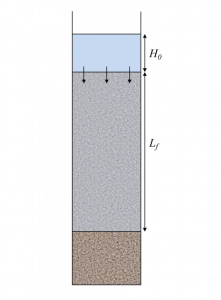6.1 Horton Infiltration Model
Horton defined infiltration capacity as “the maximum rate at which a given soil can absorb rainfall when the soil is in a specified condition” [2]. Based on observations of infiltration in the field, he deduced that the decrease in infiltration capacity over time during an infiltration event was due to flow-restricting changes occurring in a thin layer at the soil surface. He believed the key changes included: 1) packing of the soil surface by raindrop impact, 2) swelling of the soil, and 3) plugging of surface pores with fine materials [2]. Building on this conceptual framework, he developed what came to be known as the Horton infiltration equation:
![]()
(Eq. 6-1)
where f is the infiltration capacity, fc is a constant minimum value of infiltration capacity which f approaches asymptotically, f0 is the soil’s initial infiltration capacity at the start of the infiltration event, and Kf is a constant which controls the rate at which the infiltration capacity decreases as a function of time, t [3]. This model has been widely used in hydrology and related disciplines [4], and its success may be due to the correctness of its underlying conceptual framework or the flexibility of its mathematical form or some combination of the two. The main deficiencies of this infiltration model are that the parameters are not clearly related to measurable physical properties of the soil and, more importantly, that the model’s conceptual framework fails to include the most fundamental reason that infiltration rates decrease over time. That fundamental discovery had, in fact, been made decades before but apparently was not widely accepted in Horton’s time.


